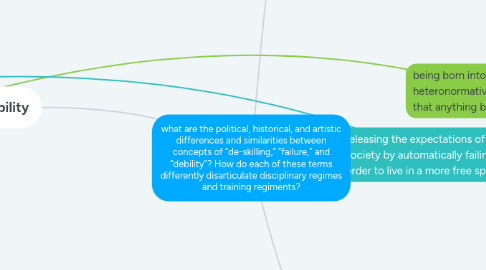
1. Deskilling
1.1. Having knowledge or a strong skill set of something and then completely rejecting it.
1.1.1. The work of art becomes the focal point for redefining skill and the value of manual labor.
1.1.1.1. narrows the gap between artist and non-artist, eliding professional and amateur.
1.1.1.1.1. In theater, no suspension of disbelief was necessary because everything was purportedly ‘real’. This notion made visual art termed 'anti-theatricality.' The solution was to completely erase the line between viewer and performer or expose the line as essential to theater's ontology.
1.1.1.2. Deskilling always requires a re-skilling if it is to convince the audience that it is more than just amateur.
1.1.2. Deskilling was seen as a critique of aesthetics-- an evocation of unalienated labor and pure sensory experience.
1.1.2.1. This process accelerated in the 1960’s and 1970’s precisely at the moment when Judson choreographers were rethinking dance as everyday gestures.
1.1.2.2. Deskilling entered art discourse in the 1980s in the context of writing on conceptual art: it denoted the tendency to outsource the production of works of art to workers in ‘other-than-art fields’ thereby placing the artist in a managerial position
2. Failure
2.1. Queer Utopia asks questions of artistic practice that attempt to visualize that which is not yet here.
2.1.1. Queer restaging of the past helps us imagine new temporalties that interrupt straight time.
2.1.2. Queer idealism may be the only way to usher in a new mode of radicalism that can perhaps release queer politics from its current death grip.
2.1.3. Utopia’s rejection of pragmatism is associated with failure. Utopianism represents a failure to be normal.
2.1.3.1. failure is the given status of queer and other minoritarian subject in the dominant social order which they live."Those of us who attempt to dream utopia within the sphere of our quotidian life must constantly overcome that disabling inertia generated by such agents of antiutopianism."
2.1.3.2. Queer utopia can achieve a virtuosity that is born from failing within straight time’s measure. It offers an escape from the confines of the 'real world'.
2.1.3.3. a challenge to the limitations of the political and aesthetic imagination. It is going against the capitalist regime, in that one does labor in order to produce a product. Capitalism is a problem because workers are oppressed and also because work has become the dominating condition of life.
2.1.3.3.1. the importance of rekindling a political imagination. Furthermore, escape itself need not be a surrender but, instead, may be more like a refusal of a dominant order and its systemic violence.
2.1.3.3.2. When someone asks me what my occupation is, I say student. But I am not always a student. I feel a pressure to define myself by what I do.
3. Debility
3.1. Defining by what someone can do versus assuming there is a baseline of what people can do and then measuring how they fit according to the physical ideals in a capitalist establishment.
3.1.1. Marx suggests “Exchange asserts an impossible equivalence between irredicibly incommensurable terms; exchange violates that incommensurability, while mobilizing it as quantifiable (in) difference.
3.1.1.1. the long entanglement of dependency and labor.
3.1.1.1.1. It is worth questioning the valorization of exchange as a conceptual framework. Reading descriptions so closely...then the words become actions shared between people.
3.1.1.1.2. Gestures of intimate inclusion are regularly used to make violence appear as equitable exchange.
3.1.1.1.3. Should needing help with daily care mandate a physical closeness that complicates the utility of actions and gestures most often associated with intimacy.

